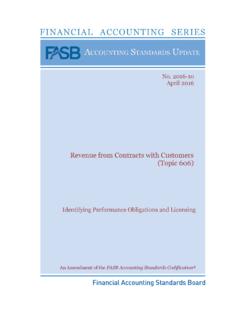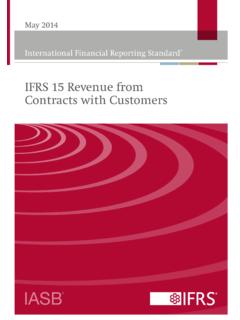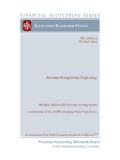Transcription of Applying IFRS - EY
1 Applying IFRSJ oint Transition Resource Group for revenue Recognition - items of general agreementUpdated June 2016 Joint Transition Resource Group for revenue Recognition items of general agreement Updated June Step 1: Identify the contract(s) with a customer .. Collectability .. Contract enforceability and termination clauses .. 52. Step 2: Identify the performance obligations in the contract .. Identification of performance obligations .. Stand-ready obligations .. Series of distinct goods and services .. Gross versus net revenue amounts billed to customers .. Customer options for additional goods and services .. 113. Step 3: Determine the transaction price .. Variable consideration .. Portfolio practical expedient to estimate variable consideration.
2 Accounting for restocking fees and related costs .. Significant financing components .. Consideration payable to a customer .. 204. Step 4: Allocate the transaction price to the performance obligationsidentified in the contract .. Exceptions to the relative stand-alone selling price method .. 215. Step 5: Recognise revenue when (or as) the entity satisfies aperformance obligation .. Evaluating how control transfers for performance obligations satisfiedover time .. Determining when control of a commodity transfers .. Measuring progress when multiple goods or services are combinedin a single performance obligation .. Practical expedient for measuring progress toward satisfaction of aperformance obligation .. Partial satisfaction of performance obligations prior to identifying thecontract.
3 266. Other measurement and recognition topics .. Warranties .. Pre-production activities .. Incremental costs to obtain a contract .. Impairment testing of capitalised contract costs .. Contract assets and liabilities .. 317. Scope of the standards .. Islamic financing transactions (this topic was raised in an ifrs context) Determining the scope for certain credit card arrangements .. Financial institutions (this topic was raised in a US GAAP context) .. Contributions (this topic was raised in a US GAAP context) .. Gambling entities fixed-odds wagering contracts (this topic wasraised in a US GAAP context) .. 35 Joint Transition Resource Group for revenue Recognition items of general agreement Updated June 20162 What you need to know The TRG has held six joint meetings and one FASB TRG meeting since itsinception to discuss a number of implementation issues.
4 In January 2016,the IASB said it did not plan to schedule further meetings of the ifrs constituents of the TRG. The FASB TRG is scheduled to meet two moretimes in 2016. During the discussions, TRG members reached general agreement onmany topics, which are summarised in this publication. Although the views expressed by TRG members are non-authoritative,they represent the latest thinking on each topic; entities should considerthese views as they implement the Transition Resource Group for revenue Recognition items of general agreement Updated June 20163 OverviewThe International Accounting Standards Board (IASB) and Financial AccountingStandards Board (FASB) (collectively, the Boards) created the Joint TransitionResource Group for revenue Recognition (TRG) to help them determinewhether more application guidance is needed on their new revenue standards1and to educate constituents.
5 TRG members include financial statementpreparers, auditors and users from a variety of industries, countries and publicand private publication summarises the issues on which members of the TRG generallyagreed at joint meetings in 2014 and 2015 and at the April 2016 meeting of theFASB TRG. TRG members representing ifrs constituents did not participate inthe April 2016 meeting. However, certain members of the IASB and its staffobserved the meeting. At its May 2016 meeting, the IASB received an oralupdate of the April 2016 FASB TRG meeting. Where possible, this publicationindicates if members of the IASB or its staff commented on the FASB TRGdiscussions. Unless otherwise specified, each issue summarises the discussionsof the joint January 2016, the IASB said it did not plan to schedule further meetings ofthe ifrs constituents of the TRG, but said it will monitor any discussions of theFASB TRG.
6 The FASB TRG is scheduled to meet two more times in 2016, in Julyand November, provided that stakeholders continue to submit additionalimplementation any views expressed by the members of the TRG are non-authoritative,they represent the latest thinking on each topic, and entities should considerthem as they implement the new standards. James Schnurr, Chief Accountantof the US Securities and Exchange Commission (SEC), expects SEC registrantsto use the TRG discussions and meeting minutes to inform their implementationof the standards. He has said that his office strongly encourages registrants,including foreign private issuers (which may report under ifrs ), that want touse accounting that differs from the TRG views to discuss their accounting withthe SEC summary, which is organised both by the steps within the standards five-step model and by TRG discussion topic, is not intended to replace anysummaries provided by the TRG or the Boards.
7 For more information aboutthese issues and those discussed by the TRG, but on which it did not reachgeneral agreement, see our publications on TRG meetings, which are and onEY ifrs 15 revenue from Contracts with Customers and Accounting Standards Codification(ASC) 606, revenue from Contracts with Customers (created by Accounting Standards Update(ASU) 2014-09).2 Speech by James V. Schnurr, 22 March 2016. Refer to SEC website help preparersimplement thestandards, the TRG hasdiscussed Transition Resource Group for revenue Recognition items of general agreement Updated June 201641. Step 1: Identify the contract(s) with CollectabilityUnder the standards, collectability refers to the customer s ability and intent topay the amount of consideration to which the entity will be entitled in exchangefor the goods and services that will be transferred to the customer.
8 The Boardsconcluded that assessing a customer s credit risk is an important part ofdetermining whether a contract, as defined by the standards, exists. If anarrangement does not meet the collectability criterion (or any of the othercriteria) to be considered a contract under the standards, an entity can onlyrecognise non-refundable consideration received as revenue when one of twoevents has occurred: (1) the entity has completed performance and receivedsubstantially all consideration; or (2) the contract has been would an entity assess collectability for a portfolio of contracts? [TRGmeeting 26 January 2015 Staff paper no. 13]TRG members generally agreed that, if an entity has determined it is probablethat a specific customer will pay amounts owed under a contract, but the entityhas historical experience that it will not collect consideration from somecustomers within a portfolio of contracts, it would be appropriate for the entityto record revenue for the specific contract in full and separately evaluate thecorresponding contract asset or receivable for TRG members cautioned that the analysis to determine whether torecognise a bad debt expense for a contract in the same period in whichrevenue is recognised (instead of reducing revenue for an anticipated priceconcession) will require would an entity reassess collectability?
9 [TRG meeting 26 January 2015 Staff paper no. 13]The standards require an entity to evaluate, at contract inception (and whensignificant facts and circumstances change), whether it is probable that it willcollect the consideration to which it will be entitled in exchange for the goodsand services that will be transferred to the customer ( , the transaction price,not the stated contract price for those goods or services). TRG membersgenerally agreed that entities would need to exercise judgement to determinewhether changes in the facts and circumstances require a reassessment ofcollectability. Judgement would also be needed to determine whether suchchanges are significant enough to indicate that a contract no longer existsunder the would an entity assess whether a contract includes a price concession?
10 [TRG meeting 26 January 2015 Staff paper no. 13]The Boards indicated that an entity s belief that it will receive partial paymentfor performance may be sufficient evidence that an arrangement meets thedefinition of a contract (and that the expected shortfall of consideration is moreakin to a price concession).Joint Transition Resource Group for revenue Recognition items of general agreement Updated June 20165 TRG members generally agreed that entities would need to exercise also acknowledged that it may be difficult in some cases to distinguishbetween price concessions, impairment and a lack of sufficient commercialsubstance to be considered a contract under the this topic was not on the TRG agenda, TRG members questionedwhether the Boards intended to delay recognition of non-refundable cashconsideration received in a number of situations indefinitely ( , amonth-to-month service arrangement when the entity continues to perform).















